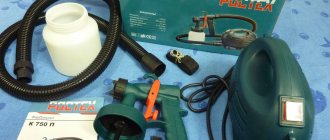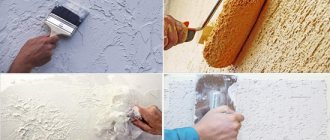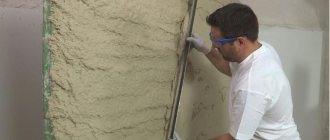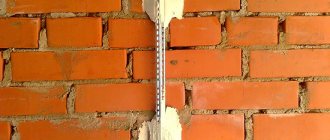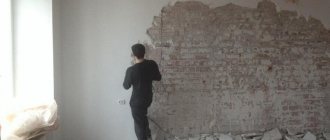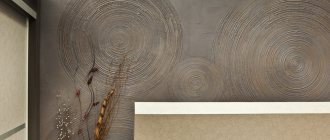Plastering station - what it is and how it works
Equipment of this type is used to obtain, mix, feed and apply mortar, thus accelerating plastering. The design of the station allows it to be used for forming self-leveling floor coverings, for pouring polystyrene concrete as insulation onto roofs or other building structures, walls, etc. On the construction equipment market you can find such models as stationary and mobile (mobile).
For the most part, stationary stations are a change house or an insulated van equipped with a receiving hopper, usually its capacity is 2.5 cubic meters. m. such equipment is installed in the working area of construction sites where surfaces are constantly being plastered. Such devices are distinguished by their high weight, but at the same time they are distinguished by high performance. They show their effectiveness in large volumes of work, for example, in the construction of modern residential buildings, warehouses, and industrial buildings.
Mobile, or mobile stations, as a rule, they are equipped with transport wheels. They are used for outdoor work, for example, in the construction of suburban facilities.
Equipment of this type is used for producing, mixing, feeding and applying mortar.
To power a stationary plastering machine, you will need to connect a power supply line of 380 v; to power mobile equipment, a voltage of 220 v is sufficient.
Structurally, the plastering station consists of:
- Reception bunker. It is necessary to receive the dry mixture.
- A screw, with its help, the components of the solution are mixed.
- A tank designed for mixing the solution. Sometimes, a water dispenser is installed in it.
- Water supply.
- Pump and solution supply system to the work site.
- Unit with control panel.
To power mobile equipment, a voltage of 220 v is sufficient.
The plaster applicator must be connected to the water and electricity supply network. The required characteristics of the connected systems are specified in the station operating manual. If there is not enough pressure in the water supply, you will have to install an additional water tank.
- The dry mixture required to obtain the solution is loaded into a hopper and fed into the mixing tank using a rotating auger. As the solution is prepared, it is transferred using a plaster pump in the direction of the supply hose.
- The solution flows under pressure from the hose to the workplace.
The plaster applicator must be connected to the water and electricity supply network.
The main parameters of the stations include:
- The power, the higher it is, the greater the volume of work the station can handle. You need to pay attention to the potential place of work. Is it possible to use a stationary station or is it possible to install a mobile unit;
- Performance. Traditionally, plastering stations produce from 1 to 6 cubic meters per hour. These numbers must be linked to the amount of work;
- Delivery range of finished plaster composition, up to 50;
- Receiving hopper capacity.
Traditionally, plastering stations produce from 1 to 6 cubic meters per hour.
Advantages and disadvantages of use
A plastering station, like any equipment for plastering walls, has its advantages and disadvantages. Let's look at them in more detail.
- High productivity;
- Reduced labor costs;
- Reducing the amount of time to complete a given amount of work;
- High quality of the finished solution.
To carry out work and maintain the station, it is necessary to ensure the presence of a team that includes:
- Masters of machine plastering;
- 4 trained workers whose responsibilities include preparing the finished solution and maintaining the station.
Experience in using such equipment suggests that such a team can produce up to 200 cubic meters in one shift. M. ready plaster mortar.
To carry out work and maintain the station, it is necessary to ensure the presence of a team.
It is worth noting that the cost of production is quite high. This is due to the cost of the source material, the size of the wage fund (wage fund), and the size of the resources consumed. To prepare the finished solution, ready-made dry mixtures are used. Costs are also negatively affected by difficulties associated with maintenance. For example, cleaning the installation requires certain preparation.
As a rule, at such a station it is possible to prepare a solution based on cement or gypsum. A plastering station is good where a large amount of work needs to be done, and very quickly.
A plastering station is good where a large amount of work needs to be done, and very quickly.
Comparison of manual and machine techniques
Regardless of what type of plaster is used to finish the surface, it can be applied either manually or using mechanized means, that is, machine stations. Each method has both pros and cons, and this causes certain difficulties in selecting the necessary equipment.
Subtleties of using machine plaster. As has been noted more than once, dry mixtures are used to prepare the finished solution; a solution made from such a mixture moves quietly through pipelines and does not stick to installation parts.
Modern manufacturers have begun to replace metal parts with polymer ones.
When using the installation, the consumer receives the following benefits:
- The solution application process is fully automated.
- Reduction in the number of workers.
- The consumer gets the opportunity to process niches and openings.
The preparation of the finished solution is carried out using special equipment. One plaster application machine can process up to 45 square meters. m.
One plaster application machine can process up to 45 square meters. m.
Handmade subtleties. Applying a layer of plaster can also be done manually. This will require the use of standard tools. Processing walls and facades takes more time. If we compare between manual and automated application methods, it will immediately be clear that manual application of plaster is several times slower than mechanized application.
Processing walls and facades takes more time.
As noted earlier, the basic difference between manual and mechanized plastering lies in the speed and quality of the work performed. In fact, the materials used are similar; the only difference is that the plastering machine works with a mixture in which additives are used.
In reality, plastering work can be done in both ways, it all depends on the expected volume of work, the skill of the workers, etc.
Machine plastering station
How to reduce the cost of repairs and do them with sufficient quality? It must be taken into account that the most significant part of the cost of repairs falls on the work of leveling walls, ceilings, and performing floor screed. Traditionally, plastering work was carried out manually with cement-sand and lime-sand mortars, using reinforcing mesh. The main, and perhaps the only, advantage of this method is the low cost of the plaster mortar. But there are a lot of shortcomings:
- low speed of work (one plasterer per day finishes 10-12 m2 of wall);
- the need for reinforcement;
- significant shrinkage of the solution upon drying, that is, it is difficult to achieve smooth walls;
- Even when plastering walls, subsequent puttying is required for subsequent wallpapering.
Therefore, even with the low cost of the plaster mortar, the total cost is significant, and the quality of the work sometimes leaves much to be desired, and the deadlines for completing the work are long.
We offer PFT machine application stations, spare parts and service to all interested parties.
Areas of application of SMN
Machine application stations have a wide range of applications:
We offer another option - instead of using plaster mortar, use machine-applied gypsum plaster mixtures. Yes, they are slightly more expensive than lime-sand mortars and this is their only drawback. When it is necessary to prepare walls for wallpapering, when using gypsum plaster mixtures, no additional putty is required, and if the mixtures are applied using plastering stations, the total cost of plastering work is often lower than when working with lime-sand mortar.
The use of plastering stations allows you to plaster up to 200 m2 of walls in an eight-hour working day. In our work, we propose to use high-performance plastering stations from PFT, known throughout the world. This is the No. 1 plastering station in Europe G4, as well as the G5, which recently appeared on the Russian market, a more advanced and productive machine, which is also more convenient for transportation. Their productivity allows high-quality plastering of a three-room apartment in 2-3 days.
Both of these machines, in addition to plastering work, allow you to perform self-leveling floors. In addition, only in our region we have a new product from PFT RITMO that allows both plastering and puttying; its small size and weight of less than 100 kg allow this machine to be used for small volumes of work. This machine fits in the trunk of a car and is ideal for small teams of 3-4 people.
All this will make it possible to set the lowest prices for work performed and at the same time actively develop, receive profit and moral satisfaction from quickly and efficiently completed work.
MACHINE PLASTERING WORKS: HIGH QUALITY and SPEED OF WORK TECHNOLOGY FEATURES
- High precision and quality of plastering stations ensures true European quality. This installation is capable of working with solutions prepared from various dry mixtures (gypsum, gypsum-lime, sand-cement). The use of a plastering station has undeniable advantages:
- The high quality of the finished solution is ensured by the continuous supply of the dry mixture into a separate container, where mixing occurs until a homogeneous mass occurs.
- Precise control of the dry mix-water ratio remains constant, which is very difficult to achieve manually. By supplying the finished solution under pressure, high adhesion (adhesion, grip) to the surface being treated is ensured. The durability and strength of machine-made plaster increases.
- Continuous supply of large volumes of solution allows you to treat large areas.
- Machine plastering saves time and human labor.
- Construction mixtures for mechanical application are much cheaper.
MACHINE PLASTERING - TIME SAVING
- You won't have to count down the weeks until the renovation work begins. Immediately after receiving an order, the master goes to the site and assesses the upcoming scope of work and draws up an estimate. After partial payment, a team of specialists begins plastering work at your site within two working days. Competent guidance from the master and high productivity of plastering stations make it possible to achieve that the time for mechanized plastering work is reduced by 4 times compared to manual plastering.
Features of the equipment and rules for working with it
The features of the plastering station include the ability to produce solutions based on the use of different binders - cement, gypsum.
The features of the plastering station include the ability to produce solutions based on the use of different binders.
How does a mechanized assistant work?
The operation of the plastering machine must be carried out strictly according to the rules, in particular, maintenance must be carried out only after disconnecting from the network and completely stopping it. As a rule, the manual for using the plastering machine indicates both safety measures and the operating procedure of the station. By the way, it wouldn’t hurt to pay attention to the duration of the warranty service
If the solution is applied in winter, then it will be necessary to organize drying of the applied layer; for this, you can use heaters. Any type, with the exception of those using open fire. The plastering plant may only be operated by trained workers who have received appropriate instruction. Responsibility for trouble-free execution of work rests with the site foreman.
The plastering plant may only be operated by trained workers who have received appropriate instruction.
How does a plastering station work and what is the principle of its operation?
The main components of the station are:
- mixer where the solution is mixed;
- a pump unit, thanks to which the prepared solution is supplied further through hoses to the gun;
- a control unit necessary for setting the necessary parameters of work processes and monitoring the progress of their implementation carried out by the station operator.
Depending on the specific model and its settings, the components for preparing the solution can be loaded into the machine by the operator himself or automatically from bags or other containers.
The machine is connected to water supply and electricity (there are also models that use diesel fuel as power).
Next, the prepared solution enters the pump unit, from where it is pumped under pressure into a hose, at the end of which a gun is installed. Using a gun, a worker applies the solution to the work surface.
The station can also be used as a simple pumping unit. In this case, a ready-made solution is poured into the machine, which is then pumped into the hose.
Stages of applying plaster using a plaster station
The application of plaster coating is carried out in several stages; let’s look at them in more detail.
Preparatory work
Grid installation. To improve the quality of the coating, a reinforcing mesh made of galvanized steel rod is fixed to the walls.
To improve the quality of the coating, reinforcing mesh is fixed to the walls.
Padding. One of the common construction operations is applying a layer of plaster to walls, ceilings, etc. In fact, this is a labor-intensive operation that takes a lot of effort and time. This is especially true for buildings with large areas. Some time ago, construction equipment companies launched stationary and mobile plastering stations onto the market. Let's consider their classification, principle of operation and the difference between automated and manual application of plaster.
For surfaces that actively absorb moisture, soils that form a protective film are used. It is designed to prevent cracking of the plaster layer.
For surfaces that actively absorb moisture, soils that form a protective film are used.
Lighthouses are zinc-coated profiles installed vertically or horizontally. A laser level is used to install them.
Lighthouses are zinc-coated profiles installed vertically or horizontally.
Direct application
This is the main stage of plastering the surface. To perform this work, a plastering unit is used, the solution obtained in it under pressure is applied to the surface to be treated.
The next operation is trimming the drying layer; to carry it out you will need to use the trapezoidal rule. To perform correct pruning, installed beacons are used. After trimming, the following operations are performed: removing beacons and grouting. At the customer's request, gloss can be applied to the plastered surface.
To perform this work, a plastering unit is used, the solution obtained in it under pressure is applied to the surface to be treated.
Drying the applied plaster
This is the last phase of plastering. The drying mode of the plaster is usually indicated in the packaging of the dry mixture. It was noted above that in the cold season it is permissible to use heating devices.
The drying mode of the plaster is usually indicated in the packaging of the dry mixture.
A few words in conclusion. Plastering equipment allows you not only to speed up the work on plastering a room, but also to ensure the proper quality of the coating.
Plastering station Grand 4s 380 V | | Technology for mortar and concrete CO
Universal plastering machine station for wide application. Fully equipped plastering station - 380 rub. , including VAT, 350 tr. - without VAT.
- Grand 4 (Grand 4) is intended for the preparation of mortars from dry mixtures (based on gypsum, lime, cement), transportation and application.
- It is used for plastering and puttying works, as well as for installing self-leveling floors and working with adhesive compositions.
intended for the preparation of mortars from dry mixtures (based on gypsum, lime, cement), transportation and application. The plastering machine is used for plastering and puttying work, as well as for installing self-leveling floors and working with adhesive compositions.
Applicable for pumping ready-made dry mixtures from various containers and tanks: used for supplying mixtures during facade work (thermal insulating, lime, lime-cement compositions), as well as interior work (gypsum and gypsum-lime mixtures).
In addition, a universal mortar-mixing pump - the Grand 380 V plastering station Grand 4s can be modified to work with putty compounds.
Plastering station 380 V characteristics
| Pump drive | 5.5 kW /380 v |
| Mixer drive | 0.55 kW |
| Performance | 10-65* l/min |
| Compressor | 0.9 kW, 200 l/min |
| Hopper volume | 180 l. |
| Dimensions | 1200mm/720mm/1520mm |
| Engine speed | 2800 rpm |
| Weight | 275 kg |
* - achieved by replacing the screw pair with another one with higher throughput.
Maximum convenience and technical reliability of the GRAND 4 plastering station are ensured by a simplified design and reliable components. Combined with reliability and performance, they guarantee a quick return on investment.
Dimensions – the maximum width of the GRAND 4 plastering station is 72 cm.
A tangible advantage for plasterers is the low loading height - 950 mm.
With reduced dimensions and a low loading level, the capacity of the receiving hopper of the Grand 4 plastering station (180 l) exceeds the capacity of the hoppers of European analogues. Such dimensions make the Gr '4 380 V plastering station more convenient when transporting and moving around a construction site. The spacious hopper reduces the number of approaches for loading the dry mixture, and the height of the receiving hopper requires less effort when lifting the bag.
The gear motor, compressor, water pump and main elements of water, air and electrical fittings for GRAND plastering stations are supplied by well-known European manufacturers. The most simplified control scheme for the Grand 4 plastering station eliminates the possibility of breakdown. And the repair and maintenance of these plastering machine units is made accessible, simple and cheap.
Equipment for plastering station 380 V:
• plaster station spray cleaner;• sprayer;• mortar (plaster) hose 15 m;• air hose 15 m;• water hose 10 m;• auger pair D 6-3;• wrench;• washing ball;• cleaning device ( shaft + cutter);• water gun;• mortar gun 1 m with rotating joint;• nozzle - 2 pcs.;
• electric cable.
Principle and features of operation of the 380 V Grand 4 plastering station
The operating principle of the plastering machine is based on the continuous preparation (mixing), delivery to the work site and automatic application of building solutions based on factory-prepared dry mixtures and water onto the surface to be treated.
The dry mixture can be loaded into the receiving hopper of the machine from bags or from a silo through a special adapter. In the receiving hopper of the plastering station, the mixture always remains dry; it is mixed with water in the lower part of the mixing tower.
Thanks to the feed drum, installed inclined, the separation of the dry mixture in the receiving hopper of the plastering station is practically eliminated during its operation.
Efficiency of a 380 V plastering station
When using a Grand 4 plastering machine, the efficiency of a team of four specialists per work shift can reach:
- with gypsum solutions ~130-150 m2;
- with cement mortars ~150-200 m2;
- when installing self-leveling floors using self-leveling solutions ~500 m2;
- when installing cement-sand and concrete screeds ~300 m2.
Plastering station 380 V - a professional and efficient plasterer's assistant
The guarantee for the plastering station is 12 months.
Please check the price of the plastering station at the production facility of SO "GRAND" or with dealers in your region. The price of a plastering station depends on the configuration. The sale of plastering stations in Russia is carried out by dealers in the regions. You can also buy a plastering station from the manufacturer in Russia by calling: +7-901-104-09-64, +7-901-016-87-73 on weekdays from 08:30 to 17:30 (Moscow time). Or leave a request in the feedback form.
[pirate_forms]
Source: https://grandrus.biz/product/shtukaturnaya-stantsiya-grand-4-380v/
Composition and principle of operation
The fully equipped station for mechanical application of plaster consists of:
- receiving hopper;
- mixing spiral;
- mixing chamber;
- screw pair;
- engine;
- water pump;
- water flow indicator;
- air compressor;
- mortar gun;
- hoses: solution, air and water;
- panels with controls;
- electrical cable.
Principle of operation:
- Turn on the water.
- Fill the mixing chamber halfway with water.
- We do a test run of the station on water (without mixture).
- Pour the dry mixture into the receiving hopper.
- Turn on the device.
- In the mixing chamber, using a spiral, the mixture is thoroughly mixed with water.
- A rotating screw pair delivers the finished solution into the hose.
- Use the water supply regulator to set the required consistency of the solution.
- Using a mortar gun, spray the mixture onto the prepared surface.
- Level the applied mixture using the rule.
- After completing the plastering work, we wash all elements with water.
On a note! Preparatory work (installation of guide beacons, priming the surface with special compounds) and leveling of the applied composition are generally the same as for manual application of plaster.
